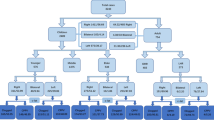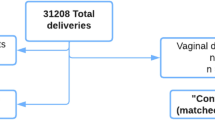Abstract
Meconium periorchitis (MP) is a rare disorder caused by fetal meconium peritonitis with subsequent spillage of meconium into the scrotal sac. The condition is seldom diagnosed correctly during fetal life and the ultrasonographic diagnoses reported vary from no diagnosis to hematoma or hydrocele. It is usually diagnosed clinically during the first year of life when a scrotal mass is an incidental finding. Here, we describe two cases of MP that were diagnosed during routine intrauterine ultrasound examination for fetal growth assessment, and confirmed after birth. One infant underwent a surgical excision of the scrotal mass, confirming the histological diagnosis of meconium periorchitis. The other was managed conservatively. Neither had cystic fibrosis. Thus, we believe that a diagnosis of MP should be considered when prenatal ultrasonographic findings are suspicious for the problem. The awareness of the ultrasonographer and the neonatologist are important for immediate postnatal management, as congenital scrotal masses may have other etiologies.
This is a preview of subscription content, access via your institution
Access options
Subscribe to this journal
Receive 12 print issues and online access
$259.00 per year
only $21.58 per issue
Buy this article
- Purchase on Springer Link
- Instant access to full article PDF
Prices may be subject to local taxes which are calculated during checkout

Similar content being viewed by others
References
Gililland A, Carlan SJ, Greenbaum LD, Levy MC, Rich MA . Undescended testicle and a meconium-filled hemiscrotum: prenatal ultrasound appearance. Ultrasound Obstet Gynecol 2002; 20: 200–202.
Wax JR, Pinette MG, Cartin A, Blackstone J . Prenatal sonographic diagnosis of meconium periorchitis. J Ultrasound Med 2007; 26: 415–4177.
Kenney PJ, Spirt BA, Ellis DA, Patil U . Scrotal masses caused by meconium peritonitis: prenatal sonographic diagnosis. Radiology 1985; 154: 362.
Sukcharoen N . Prenatal sonographic diagnosis of meconium peritonitis: a case report. J Med Assoc Thai 1993; 76: 171–176.
Mene M, Rosenberg HK, Ginsberg PC . Meconium periorchitis presenting as scrotal nodules in a five-year-old boy. J Ultrasound Med 1994; 13: 491–494.
Brown-Harrison MC, Harrison AM, Reid BS, Cartwright PC . Meconium periorchitis--a cause of scrotal mass in the newborn. Clin Pediatr 2000; 39: 179–182.
Dehner LP, Scott D, Stocker JT . Meconium periorchitis: a clinicopathologic study of four cases with a review of the literature. Hum Pathol 1986; 17: 807–812.
Herman TE, Siegel MJ . Meconium periorchitis. J Perinatol 2004; 24: 188–190.
Das A, Murphy A, McMahon M, Gormally SM, Corbally M . Fetal meconium peritonitis: the ‘vanishing hydrocele’ sign. Arch Dis Child Fetal Neonatal Ed 2003; 88: F74.
Sung T, Riedlinger WF, Diamond DA, Chow JS . Solid extratesticular masses in children: radiographic and pathologic correlation. AJR Am J Roentgenol 2006; 186: 483–490.
Taylor GP . Pathology of the pediatric regio inguinalis: mysteries of the hernia sac exposed. Pediatr Dev Pathol 2000; 3: 513–524.
Várkonyi I, Fliegel C, Rösslein R, Jenny P, Ohnacker H . Meconium periorchitis: case report and literature review. Eur J Pediatr Surg 2000; 10: 404–407.
Berdon WE, Baker DH, Becker J, De Sanctis P . Scrotal masses in healed meconium peritonitis. N Engl J Med 1967; 277: 585–587.
Fair KP, Cho MH . Pathological case of the month. Meconium periorchitis. Arch Pediatr Adolesc Med 1997; 151: 853–854.
Wittenberg AF, Tobias T, Rzeszotarski M, Minotti AJ . Sonography of the acute scrotum: the four T's of testicular imaging. Curr Probl Diagn Radiol 2006; 35: 12–21.
Soferman R, Ben-Sira L, Jurgenson U . Cystic fibrosis and neonatal calcified scrotal masses. J Cyst Fibros 2003; 2: 214–216.
Boccon-Gibod L, Roucayrol AM . Meconium periorchitis. Pediatr Pathol 1992; 12: 851–856.
Williams HJ, Abernethy LJ, Losty PD, Kotiloglu E . Meconium periorchitis—a rare cause of a paratesticular mass. Pediatr Radiol 2004; 34: 421–423.
Author information
Authors and Affiliations
Corresponding author
Rights and permissions
About this article
Cite this article
Regev, R., Markovich, O., Arnon, S. et al. Meconium periorchitis: intrauterine diagnosis and neonatal outcome: case reports and review of the literature. J Perinatol 29, 585–587 (2009). https://doi.org/10.1038/jp.2009.15
Received:
Revised:
Accepted:
Published:
Issue Date:
DOI: https://doi.org/10.1038/jp.2009.15
Keywords
This article is cited by
-
Fetal magnetic resonance imaging contributes to the diagnosis and treatment of meconium peritonitis
BMC Medical Imaging (2020)
-
Extratesticular masses in children: taking ultrasound beyond paratesticular rhabdomyosarcoma
Pediatric Radiology (2015)
-
Conservative management after prenatal ultrasound diagnosis of meconium periorchitis
Journal of Medical Ultrasonics (2014)



